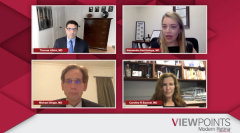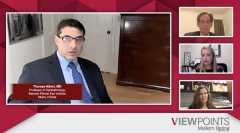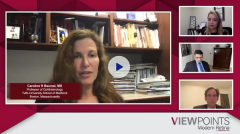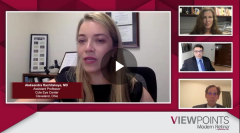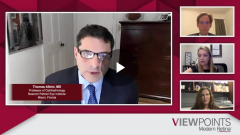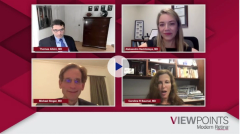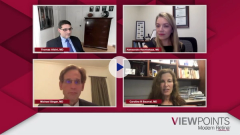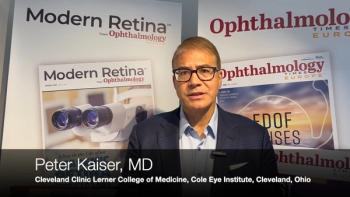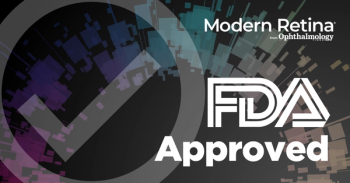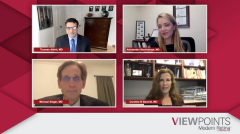
The impact of COVID-19 on the management of wet AMD
Episodes in this series

Caroline Baumal, MD: Aleksandra, why don’t you tell us how things are going at the Cole Clinic with COVID-19 [coronavirus disease 2019] and how that’s affected you and your patient flow?
Aleksandra Rachitskaya, MD: It has affected all of us. There is no question about it. We actually looked at our data, and 1 of the studies that we have done is to look at patients who kept their appointments, especially when we talk about MD [macular degeneration] patients. With patients who are on injections, we do want to continue seeing them. We also looked at patients who had canceled appointments and no-show appointments. When you look by subspecialties, retina actually kept most of the patients, and then those patients who canceled were rescheduled to be seen.
We even analyzed a little more by looking at the patients who got the injections, patients with AMD [age-related macular degeneration] and diabetes, as well as our patients with RVO [retinal vein occlusion], and it was interesting. We found that when we looked at the overall population—not individual patients, since we all can think of an individual AMD patient who came back and lost vision because of a delay in care—on average, the AMD patients did pretty well even with that delay. This is the care delay in March, when we had the mandated lockdown. On average, there was a 5½-week delay. In fact, patients with diabetic retinopathy who require injections and RVO patients tend to lose more vision in our experience.
We did this study, but we are still dealing with COVID-19. We are still having patients who have delayed care. It is not something that is over. Based on all the things that we talked about being excited about, hopefully we can learn from our COVID-19 experience what the patients’ needs really are when our patients can come in as frequently as we would want.
Caroline Baumal, MD: That is a great point. Tom, how are things in Florida?
Thomas Albini, MD: Similarly, we [at Bascom Palmer Eye Institute] came to a grinding halt in March. Our clinics were cut by about 80%, and that was true in the retina service too. We were really seeing only emergent cases and urgent follow-ups that absolutely needed to be seen, and we were doing injections. We looked at patients who had been receiving injections at a fairly regular interval, and we just had those patients come in for the procedures themselves and not get an OCT [optical coherence tomography] and get a full visit. It was surprising to me that there was a substantial group of patients who really wanted to see their OCTs, even if it meant staying in the hospital, with all the excitement about COVID-19 and whatnot. The hospital was empty at that point.
We started bringing them back in, and now the vast majority of patients are getting OCTs and full evaluations again. As Mike was saying earlier, my patients, like everybody’s patients, like to look at the OCTs, and they get good at reading them over time. They want to see what is going on, even if they get an injection every single time. That has been our practice.
The other thing we have done is for patients who weren’t getting injections at very regular intervals, but needed to be monitored—maybe they have a disciform scar in 1 eye but dry AMD in the other eye, or they were at high risk for having problems but did not have wet AMD—we were bringing those patients in for imaging-only visits. They would come in and get an OCT. Then the OCT would be reviewed, and we’d call them or do a telemedicine visit. That was very popular for a while. We have shifted from telemedicine to bringing patients back into the clinic so we can actually do a real exam.
In ophthalmology, telemedicine is very useful. This kind of hybrid, where you have them get an imaging study and then talk to the patient, is an interesting option that works for a lot of patients. You cannot really beat a real examination, especially for uveitis patients, and with uveitis, that hybrid is impossible. For a lot of patients with medical retina, you could do it, but you still might miss something in the peripheral retina or something else that is going on, like new onset corneal edema that is causing the patient’s problem. We are doing less of that through telemedicine, but it is still something we are trying to do as much as we can to help patients stay out of the clinic unless they absolutely need to be there.
The other thing that has changed is we do not have patients coming in with visitors as often, and in the AMD population, that’s very common. Somebody brings the patient in and then sits with them for 3 hours. We cut our waiting room volume in half by allowing visitors only when it is absolutely necessary for patients to have somebody with them.
Newsletter
Keep your retina practice on the forefront—subscribe for expert analysis and emerging trends in retinal disease management.

